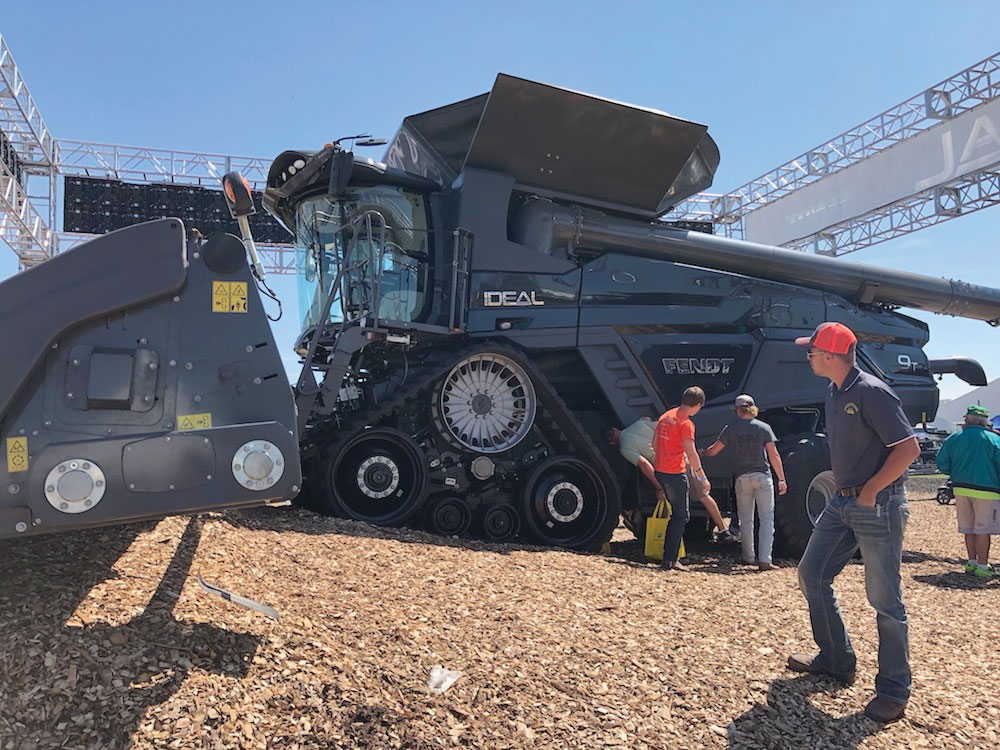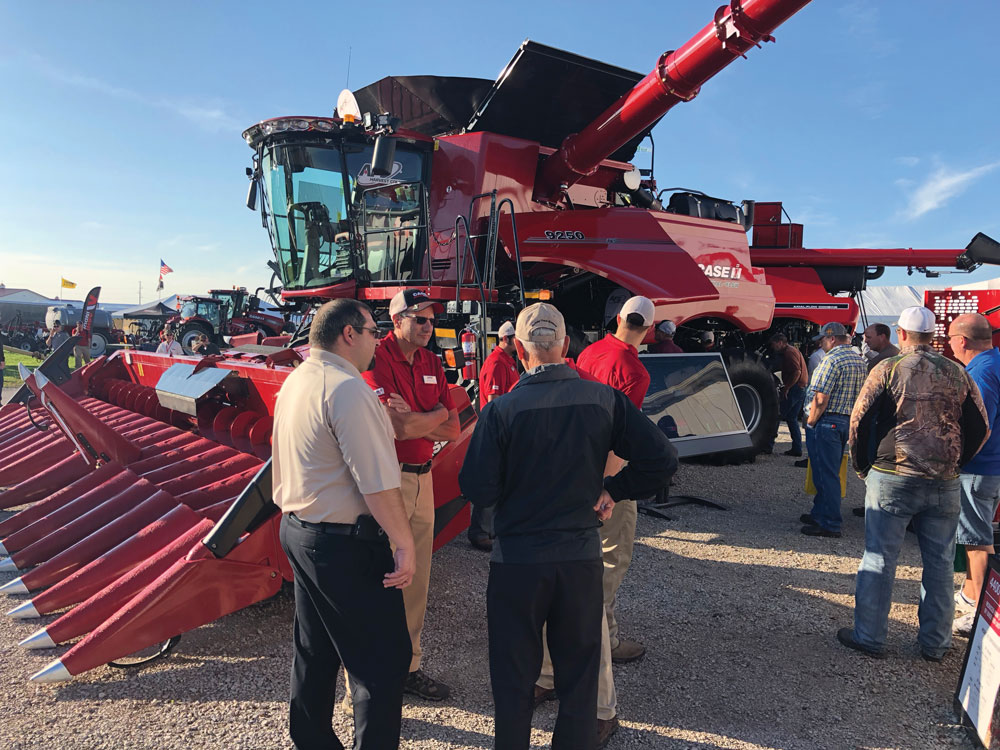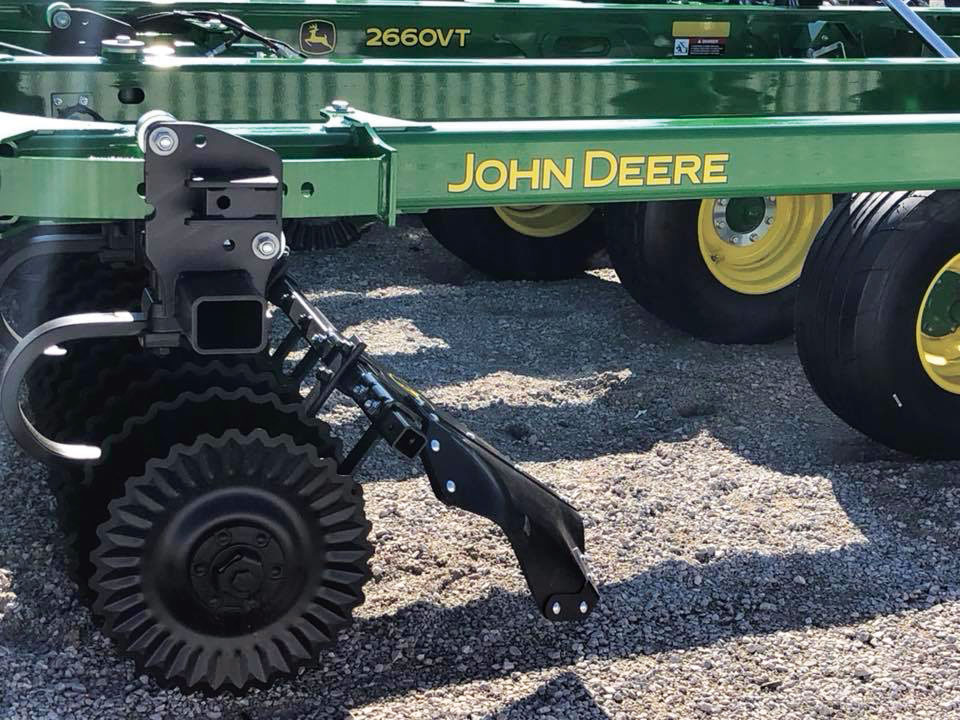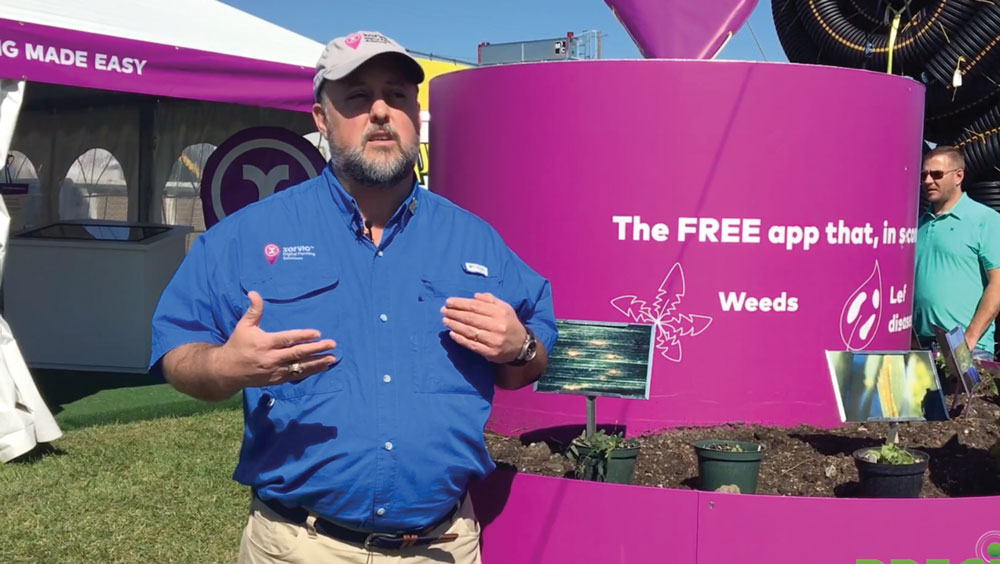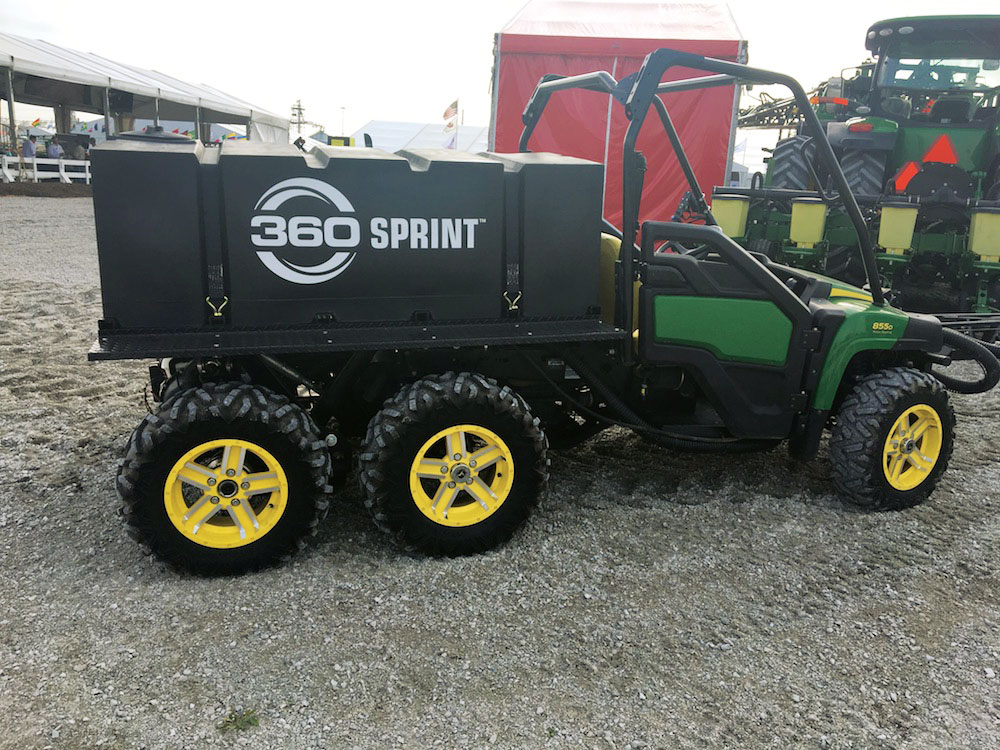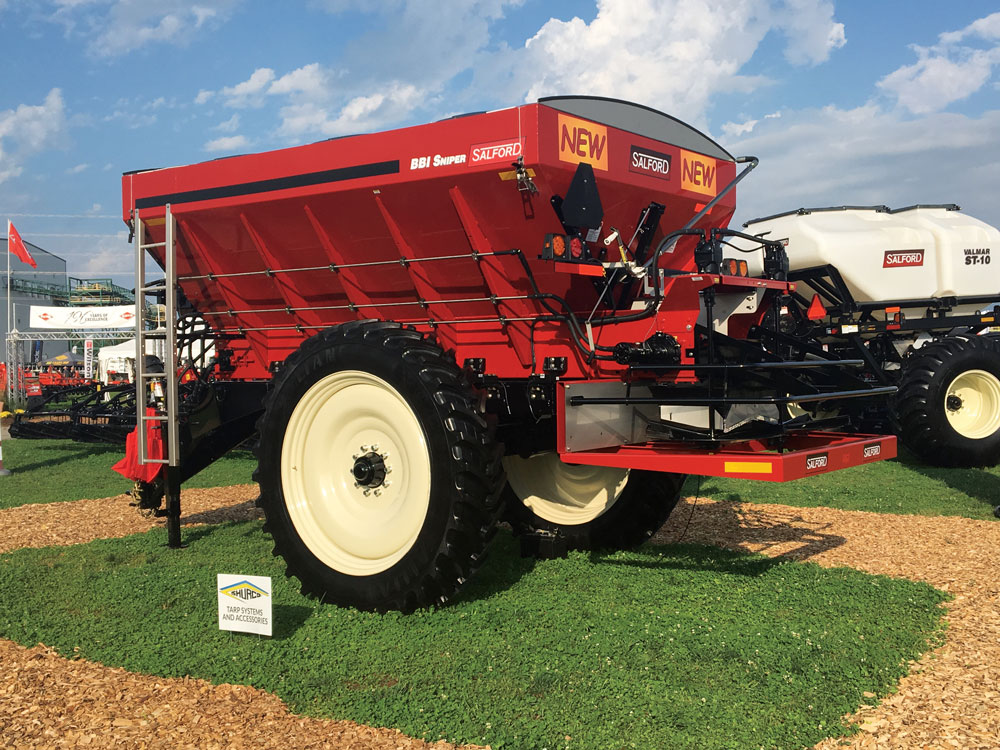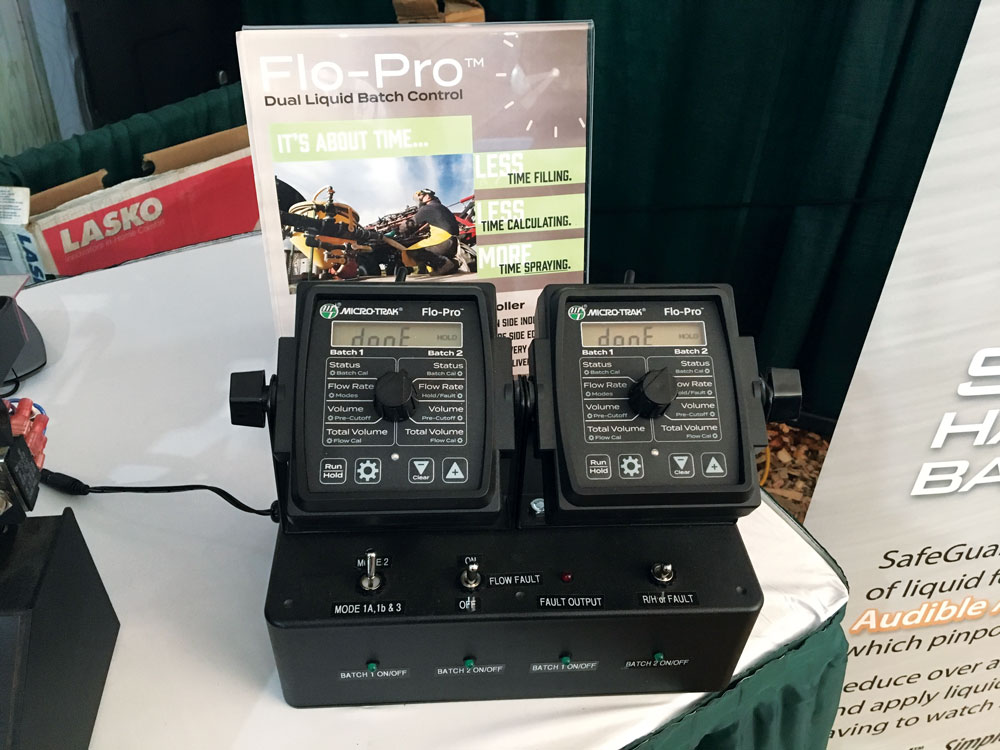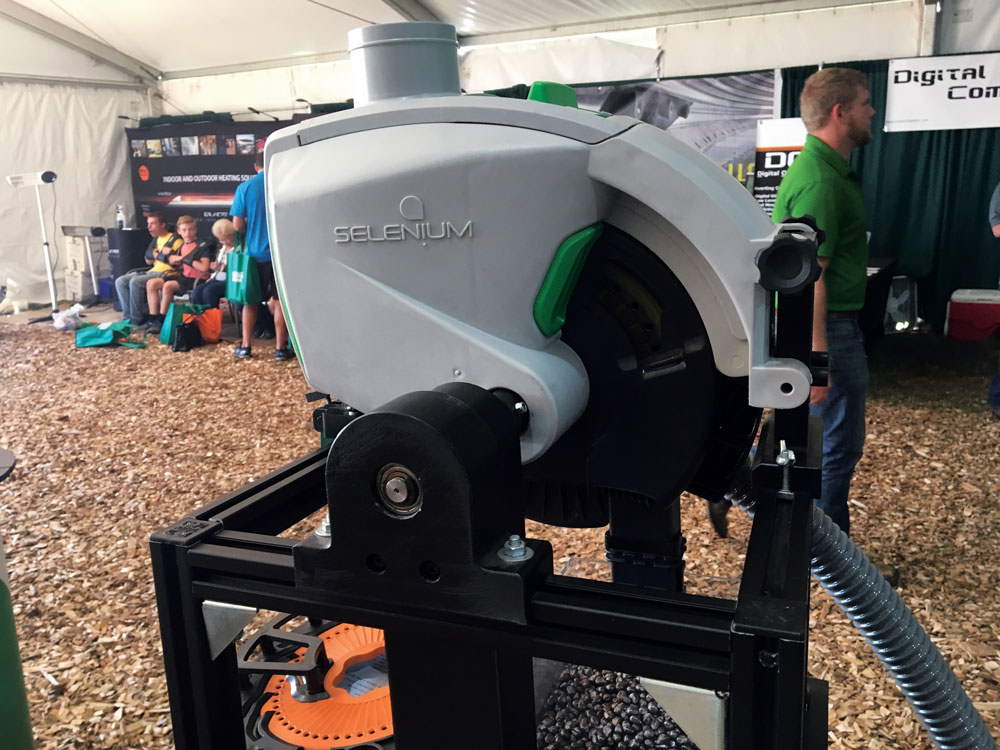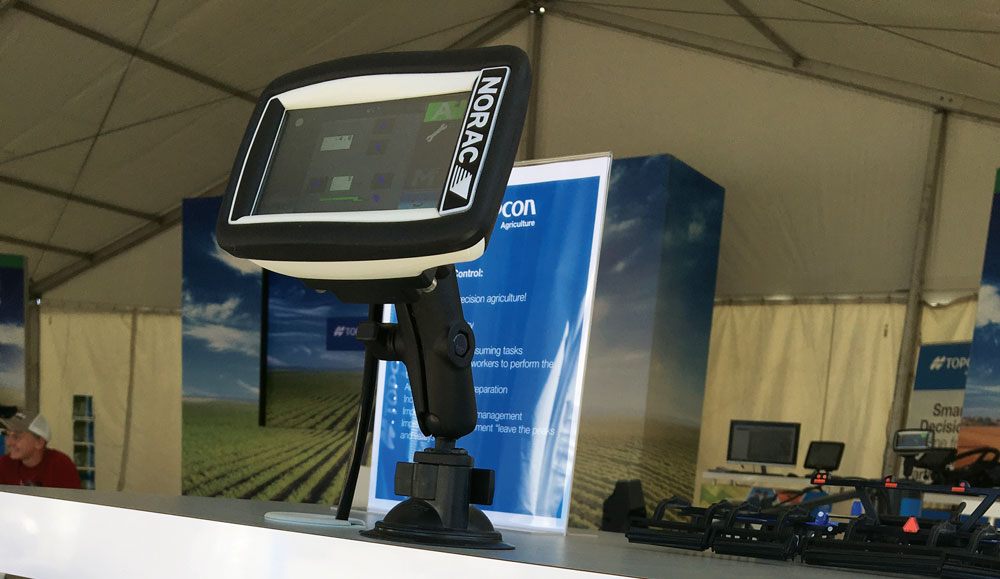Farm Equipment sent 11 staffers to the Farm Progress Show in Boone, Iowa, to cover the latest innovations and trends in the farm equipment market. What follows are the most noteworthy product launches, industry notes and trending news editors found impacting the North American farm machinery market. For more on what our editors saw, heard and experienced on the show grounds, visit Farm Equipment’s Facebook and Twitter pages (#FPS18). You can also find additional coverage and exclusive video interviews on www.Farm-Equipment.com.
NEW COMBINES
AGCO’s Ideal Combine Draws Crowds
Perhaps the biggest story line at the show was AGCO’s new Fendt Ideal combine. After AGCO first revealed the machine earlier this summer at the Canada Farm Progress Show in Regina, Sask., the company had three of them on display in Boone. This was a good thing, said company officials, given the constant crowd that the combines were attracting to the AGCO tent. AGCO says the company has spent 7 years developing the product up to this point. The development process included customer and dealer feedback at every step. The design of the Ideal essentially started from scratch, the first such “clean sheet” axial combine in 30 years.
In an interview with Farm Equipment at the Farm Progress Show, Bob Crain, AGCO senior vice president and general manager, Americas, says the new combine will be rolled out slowly. Only 11 dealers will initially sell the Ideal, with more dealers added in the fourth quarter, with possibly around 100 dealers carrying it by 2019, he says. The Ideal is expected to be fully rolled out in 2020.
“We are truly taking a ‘crawl, walk, run’ approach,” he says.
The combine will be available in Class 7, 8 and 9 to match the harvest capacity needed by any operation. More details on the Ideal combine can be found in previous coverage at www.Farm-Equipment.com/articles/15748.
Case IH Unveils New Series Axial-Flow Combines
Case IH also introduced its new 250 series combine, new for 2019. Ryan Blasiak, harvesting marketing manager, summed up the developments in three areas. These include several enhancements to the feeder house (fore-aft adjustments) top shaft assembly area, support for heavier heads and narrow-row chopping heads. Second is the optional in-cab adjustments to change the position of the cage vane angle to slow or accelerate grain material through the combine and the technology offering. And third, Blasiak says, is the standard-issue AFS Connect is to allow dealers to better diagnose and be aware of service intervals to help customers in downtime/update. “Plus, the optional Harvest Command automation allows any driver to be a seasoned combine operator,” he says, noting that 16 sensors allow the seamless adjustment of 7 different combine functions.
Deere Enters Vertical Tillage Market
John Deere marked its entrance into the crowded vertical tillage market at the Farm Progress Show with the release of its new 2660VT Variable-Intensity Tillage Tool.
The unit is based on a shallow concavity Commander blade. According to Deere, the 2660VT allows operators to customize the gang angle from 0 degrees for sizing residue and vertical soil movement, to 12 degrees for aggressive horizontal soil movement and to bury crop residue. The gang angle can be adjusted with a manual slider or with TruSet Tillage Technology for more precise, one-degree adjustments and prescription tillage capabilities from the cab.
Automated, on-the-go TruSet tillage depth and rolling basket pressure adjustments, as well as documentation and prescription-based tillage on the Generation 4 Display, are standard on both five-section and three-section models.
Some would argue the Deere unit isn’t true vertical tillage. Curt Davis, director of marketing and product management for Kuhn Krause doesn’t consider anything over a 10-degree angle to be vertical tillage. Mike Cleveland, vice president of sales for Great Plains, agrees. “If a farmer wants to own a high-speed disc, that’s fine; there’s a lot of them out there. But if you want vertical tillage, if it’s got a concave blade running at an angle it’s not vertical. That’s our position. We tell our dealers that. And we tell farmers that,” says Cleveland.
“True vertical tillage, it’s not that crowded. There’s a crowded market in what we call the high-speed disc business, but true vertical tillage is not that crowded. There’s us (Great Plains), Summers and Salford to my knowledge that run a true vertical tillage tool with blades on it,” says Cleveland.
According to other manufacturers, the Deere unit is very similar to other products on the market and in some instances has near identical parts. “We’ve had vertical tillage in the market for a number of years and at Kuhn Krause we evaluated what the customers were looking for and came up with a machine,” Davis says. “You really have to be in the market to know what the customers are after and they’ve obviously taken what they think is going to work and that’s probably where we differ between companies. I’m not sure what they’re expecting to gain in the vertical tillage market with a product that is very similar to others in the industry,” Davis says.
Great Plains, Summers and Kuhn-Krause all say they have concern over Deere continuing its push for dealer purity. “If they’re truly going to gain purity with their dealers, then they’ve got to provide the products that John Deere dealers are sourcing from other manufacturers. And this fills one of their holes,” Cleveland says.
“We’ve got quite a few dealers who represent Kuhn Krause who are John Deere dealers and I’m sure that pressure will be coming from their major manufacturer to carry the John Deere machine,” Davis says. “But again, we have to go back to performance, industry longevity, the history that we have and the differential items with the machine that we know we can perform well and what the customer is after. Those customers will end up telling the story in the end of what they’re looking for and what performs better.”
High Speed Tillage Debuts, Too
In addition to the vertical tillage solution that it developed in-house, John Deere also showcased its freshly unveiled 2680H unit, or what it calls its high-performance, high-speed tillage tool as its entrant into the high-speed tillage business. The 2680 unit is licensed from Fargo’s Norwood Sales (which they brand as Kwik-Till), and was the first time seen following an announcement last June. Paul Richardel, John Deere Tillage Product Line Manager notes that it is operated at 12-14 mph, to incorporate residue in the front and leave a nice seedbed in the back. “We recognized that a lot of farmers want to get faster,” he says, pointing out that going wider is not always desired by the farmer.
Eric Broadbent, director of sales for Kinze Manufacturing, gave an update on the Mach-Till (licensed from Degelman and made in Kinze’s plant) that was announced last January. “It started out as a manufacturing agreement and then modified its way into a licensing agreement,” he says, noting that Kinze produces Pro-Tills (Degelman brand) and Mach-Tills for both companies.
Broadbent says the Mach-Till was attractive to give dealers a totally new equipment segment from Kinze. “Dealers were looking for this type of product from Kinze and this segment of tillage is growing at a rapid rate and our dealers can embrace that upswing as it continues to grow.”
Results from dealers and customers have been better than anticipated. “We’re on target to meeting its second-year sales goal in year one,” he says. He added that Kinze also created a new product specialist position (unique in Kinze’s culture) in Justin Render as to assist dealers and growers with the new segment. “As all tillage is, everyone wants to see it run in their backyard. We’re doing 16 different midwest events this fall to demonstrate it.”
Autonomy Continues to Advance
Technology developer Smart Ag unveiled its AutoCart autonomous technology. Designed to assist with labor shortages on farms, the aftermarket kit can be implemented into the cab of a combine during grain harvest to control a tractor in a separate part of the field.
The system comes with an additional remote farmers can use to stop the tractor immediately when needed. With price points estimated between $35,000-$40,000, AutoCart is currently being run on a limited scope with John Deere equipment and anticipated for a full commercial release in 2019, according to Mark Barglof, chief technology officer for Smart Ag.
“Right now, the system works for 8R series tractors, but as we continue into the future, we plan to increase the types of equipment the system can run on it,” says Barglof. “We’ve got partnerships with Bottom Line Solutions in Illinois, and AgriVision, a local Deere dealer.”
xarvio Introduces Weed, Disease Detection to North America
Germany-based xarvio Digital Farming Solutions introduced its new scouting app, with image recognition technology to identify — with near 90% certainty — 11 known diseases and 11 weed species in the U.S. Farmers have the ability to take an early-stage, in-field photo and cross-reference the image in the scouting apps database to identify the disease or weed.
Based on several hundred thousand images and machine learning algorithms, the app also assigns a “confidence index” percentage with the classification,
“Within the next 2-3 years, we’ll be rolling out smart sprayer technology that uses this same image recognition technology,” says David Gray, U.S. commercial manager. “As the sprayer is rolling through the field, cameras will recognize different weed varieties and select from multiple herbicides to best suit conditions and reduce over spraying and weed resistance.”
Claas Introduces ‘First Claas Used’
Claas introduced its new First Claas Used program for used equipment. The program has three classifications — Gold, Silver and Bronze. The Gold level is exclusively for combines that are 5 years old or newer with fewer than 2,500 engine hours. Silver covers combines and forage harvesters, also 5 years or newer and fewer than 2,500 hours. The bronze classification is open to all Claas equipment and contains no hour minimums.
Dealers who are interested in participating in the program must send a technician for training to become a First Claas Used certified technician, says Allen Miller, remarketing manager for Claas.
The company also introduced Click to dealers ahead of the launch. It’s an inspection app that allows the dealer to walk around the unit and check all the areas needed for the machine to go up on FCU.Claas.com, the site farmers can search for certified used Claas equipment. The program is only available through the Claas dealer network.
360 Sprint Seeks to Set Pace of Fertilizer Refilling
360 Yield Center debuted a prototype of its new 360 Sprint machine, designed for on-the-go liquid fertilizer refills. A 300-gallon tank, mounted on a John Deere Gator, has a connector in the front that can attach to a moving planter in the field and refill liquid nitrogen or starter fertilizer on the planter. With the ability to cover as much as 30% more acres in a day, the company field tested 4 machines this spring including on founder Gregg Sauder’s farm.
“Farmers are spending a lot of money on high-speed planters and to be sitting as much as 12 minutes to refill fertilizer, as much as 10 times per day, that’s more than 100 acres a day lost on pitstops,” Sauder says. “This system can load 300 gallons in less than 4 minutes and we see broader use with farmers looking to chase strip-till bars in fall to add liquid N.”
Salford BBI Sniper
Newly released at the show from Salford Group, the BBI Sniper spinner spreader offers targeted dry fertilizer application at widths up to 120 feet and uses patent-pending technology to follow prescription application targets by rapidly adjusting its spread pattern on the fly.
Brad Baker, senior product manager with Salford Group notes the system features section control allowing the unit to apply in 12 sections, starting with a 40-foot spread pattern.
“It is independently controlled on both sides, by a bed chain conveyer on both sides of the hopper, feeding individually controlled spinner spreaders,” Baker says. “Also featured is the dynamic calibration system, which integrates the scale system into our controller.”
The proprietary ISOBUS controller allows operators to calibrate the machine on the fly. This includes taking regular scale readings, feeding the differential in weight in the hopper into the controller and making the calculations to recalibrate to the desired rate.
The system will have a limited release in 2019 model year and the technology will be applied to other BBI product lines and spinner spreaders, including both pull-type and chassis mount products.
Micro-Trak Flo-Pro
Rex McClellan with Micro-Trak Systems debuted the new Flo-Pro Batch meter, which can monitor 2 batches of chemical injection or tank transfer by setting the monitor for volume amount, and then counting down digitally for an automatic shut-off.
“The monitors will count down the volumes then automatically shut off either an electric pump or a 12 volt shut off valve,” McClellan says.
The systems are available with a list price of $875 for the console, plus the cost of whatever size flow meter is needed for the farmer’s operation.
Intelligent Ag Solutions Recon SpreadSense
Intelligent Ag Solutions revealed its new Recon SpreadSense technology, the industry’s first blockage monitor for floaters. The system utilizes acoustic technology to detect flow through the machine.
“Much like a stethoscope, as product hits the impact plate, it processes that information and sends that audio signal to the electronic control unit,” says Matt Grove, product manager. “The signal is then processed and sent wirelessly to a tablet in the cab for the operator to see.”
The tablet interface has quick identifiers as a mass flow number, to show quickly product is moving through the machine, and then identify blockages through green or red indicators.
J.Assy Selenium Seed Meter & Visum Flow Blockage System
Brazilian manufacturer J.Assy made its second appearance at the Farm Progress Show and showcased the Visum wireless flow blockage system for strip-till fertilizer application. Working with Montag Mfg. for distribution, the system is wireless and consists of a hose sensor, vibration flow detection and in-cab monitor. If there is a blockage in the boot of the row unit or in the meter, the operator will get an audible indication of the plug in the row, and which row, says Dale Simpson, general sales manager for J.Assy.
“Many farmers running dry fertilizer application in a strip-till system are doing so without any real indication of knowledge if they are getting flow to each row unit,” Simpson says. “I liken it to there not being a farmer around who wouldn’t have a monitor on his seed meter for the corn planter, so why wouldn’t you want to have the same kind of tracking with dry fertilizer application.
Cost of the system is $260 per row, and available on a variety of strip-till row unit models, Simpson says.
J.Assy also introduced its new Selenium vacuum seed meter, which has kits for soybeans and sorghum. The company is partnering with planter row unit manufacturer Harvest International for production.
“One of the key differentiators with the product is with crop changeover,” says Simpson. “When changing from one crop to another, it’s as simple as popping out one kit and replacing with another one, without adjusting singulators, knock-out wheels or small pins.”
Topcon Tillage Depth Control
Topcon Agriculture introduced its the new Tillage Depth Control system. Allowing a tillage implement to be automated and controlled, the new system, powered by Norac, allows farmers to maintain the correct depth without having to make adjustments on the fly while in the field.
The sensor system and controls allow for operation through harder field elements and maintaining the correct setting for the operator.
“You can know exactly where you are for depth, unlike using rotary sensors or position sensors in a cylinder you’ll get out of sequence and won’t be measuring actual depth of your tillage tool,” says Chris Carleton, OEM account manager.

